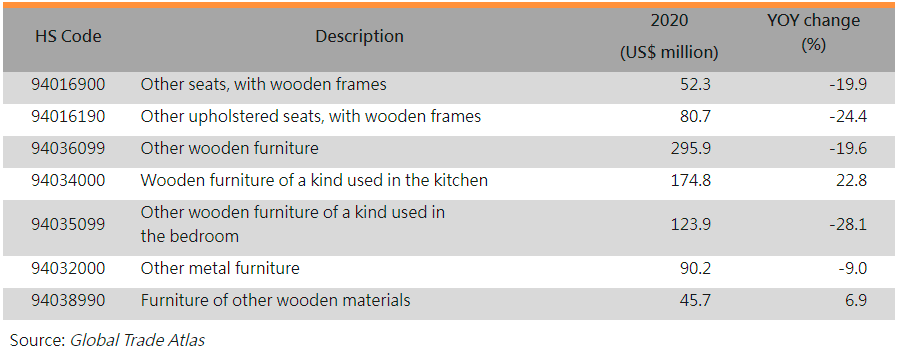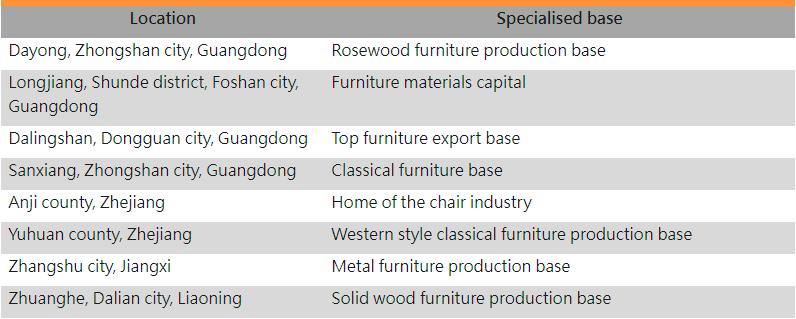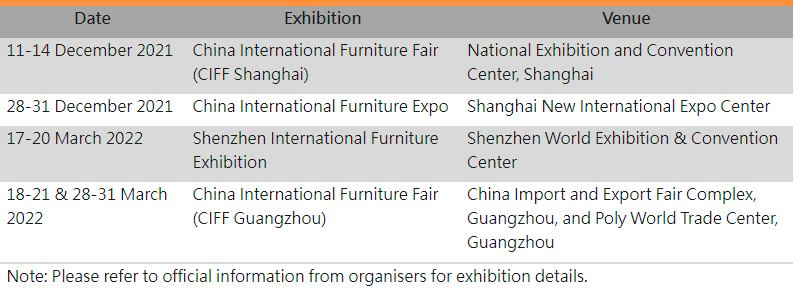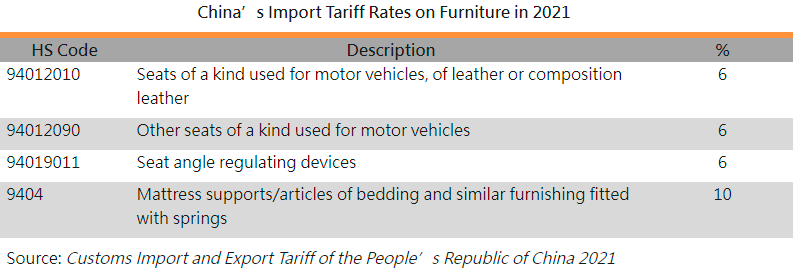

I. Market Overview
As housing conditions continue to improve in China, people are becoming increasingly willing to spend money on home decoration. In 2020, per capita disposable income grew 4.7% year‑on‑year. This increased purchasing power has helped the furniture market to expand significantly. Nevertheless, in the wake of the Covid-19 pandemic, the supply of materials has tightened and housing need has declined. According to figures from the National Bureau of Statistics, the combined business revenue of furniture manufacturers dropped 6.0% year‑on‑year to RMB687.54 billion in 2020, while total profits declined 11.1% to RMB41.77 billion. Production volume, however, dropped 1% year‑on‑year to 910 million pieces, a level comparable to the previous year.
Under the “dual circulation” development strategy of the 14th Five-Year Plan, the furniture industry not only needs to concern itself with the domestic market, but is also expected to look for opportunities to expand globally. China’s furniture exports are showing sustained growth. According to the Statistical Communiqué on the 2020 National Economic and Social Development, the value of exports of furniture and furniture parts was RMB403.9 billion in 2020, up 12.2% on the year before.
Urbanisation, China’s main policy for stimulating domestic demand, is likely to drive growth in the furniture market. Data from the National Bureau of Statistics shows that the urbanisation rate of permanent residents in China reached 63.9% in 2020, up 3.3 percentage points on the previous year. Urban wage earners and peasant families who have settled in towns and cities have become major furniture buyers. Statistics compiled by the State Council reveal that, in 2020, some 39,000 old residential communities needed renovation. These communities cover about 7 million households and therefore renovating them is likely to significantly drive up the demand for furniture.
Mainland furniture consumers can be roughly divided into three groups: avid consumers, luxury and branded goods consumers and average wage‑earning consumers.
1. Avid consumers: this is a very rich group of consumers with little concern for price. They usually favour expensive western style, classical Chinese style or avant-garde furniture.
2. Luxury and branded goods consumers: these consumers want furniture to reflect their taste and style. They appreciate aesthetics and cultural elements. They are at the forefront of trends in fashion, lifestyle and price.
3. Average wage-earning consumers: this group represents the majority of consumers, who see price and quality as the dominating factors when making purchases. They often shop around before buying.
According to the Industrial Classification for National Economic Activities issued by the National Bureau of Statistics, the furniture industry is divided according to product type, into wooden, bamboo or rattan, metal, plastic and miscellaneous furniture manufacturing.
A wide range of products is available. This can be broken down into furniture for the home, hotel and guest house furniture, office furniture, and public institution furniture.
1. Home furniture is furniture used in the homes of urban residents, including sofas, TV cabinets, tables and chairs, kitchen furniture and bedroom furniture.
2. Hotel and guesthouse furniture is made up of dining tables and chairs, sofas and guest room furniture.
3. Office furniture includes items such as desks, chairs, bookshelves and cabinets for use in the office.
4. Public institution furniture includes items for use in public sector facilities, such as medical, sports, cultural and educational institutions.
iiMedia Research points out that consumers have three main concerns when buying furniture: the environmental impacts (cited by 53.2% of consumers), the material used (52.7%) and the appearance and design (49.4%). With the rolling out of national environmental policies under the 14th Five-Year Plan, consumers and manufacturers now care more about the environmental friendliness of the materials used and their effects on the human body and the environment. They may be concerned, for example, by the formaldehyde content in a particular product.
In terms of materials, metal furniture (50.9%) and wooden furniture (40.5%) together account for more than 90% of the furniture manufactured in China, followed by soft furniture (8.6%). In 2020, the production of metal and wooden furniture increased by 0.4% and 1.9% respectively from the previous year, while the production of soft furniture fell slightly by 1.4%.
With an annual growth of 20%, the custom‑made furniture market is one of the industry’s bright spots. During the Covid-19 pandemic, all industries have been impacted to some extent or other. However, the custom‑made furniture market is expected to grow to RMB334.2 billion by 2024.
Custom‑made furniture can be ordered on a piece‑by‑piece basis or for the whole household. Market segments are classified according to the material, usage and space as well as the type of wood and the style involved. Compared to ready‑made furniture, custom‑made furniture makes better use of space and reduces waste of resources. Currently, consumers mostly custom order kitchen cabinets and wardrobes, while other items such as bookcases and shoe cabinets are seldom ordered.
Businesses specialising in custom‑made furniture are now collaborating with property developers to make residential properties appear more elegant. Such collaborations are already commonplace in the custom‑made furniture markets of first‑ and second‑tier cities as well as the majority of third‑ and fourth‑tier cities. According to Chinabaogao.com, 42% of consumers ordering custom‑made furniture are from the younger generation. This is related to the fact that younger consumers have tended to pursue home‑style living in recent years.
Mainland consumers’ demand for outdoor furniture has gradually been increasing too. Outdoor furniture is mainly used in the outdoor areas of homes, hotels, restaurants and tourist sites. Outdoor furniture can generally be classified into fixed, movable or portable types. According to a mainland research report, the mainland market for outdoor furniture grew from RMB1.98 billion in 2012 to RMB2.86 billion in 2020, and is expected to reach RMB3 billion in 2021.
Office furniture is mostly made of wood and metal. The production bases are largely centralised around the Pearl River Delta, the Yangtze River Delta, the Bohai Bay, and the north‑east and the west of China, which together account for 90% of the industry. Data from the China National Furniture Association and the China Light Industry Information Centre indicates that, due to the pandemic, production volume in the first three quarters of 2020 declined by 5.4% year‑on‑year to 630.19 million pieces.
Demand for children’s furniture is on the rise. As living standards improve, parents are increasingly willing to buy suitable furniture to create a good environment for their children’s development. With the full implementation of the three‑child policy under the 14th Five-Year Plan (2021-2025), pundits believe that this market has further room for growth. According to data from the National Bureau of Statistics, the number of children under 15 reached 253 million in 2020, including 10.04 million newborns. A mainland industry intelligence website (leadleo.com) forecasts that the market for children’s furniture could reach RMB182.5 billion by 2024. Countrywide, there are some 1,000 companies producing children’s furniture, the vast majority of them being small‑scale operations. When buying children’s furniture, parents’ prime consideration is safety, and most of them prefer to buy from reputable brands. The Standardisation Administration of China (SAC), in issuing a directive on the main points of national standardisation work in 2021 on 6 April 2021, said that it would redouble its efforts to develop national compulsory standards and supportive recommended standards for children’s furniture. These are expected to help improve production quality substantially.
With the advance of AI, big data and 5G, smart household items may become mainstream. Many countries are demanding reductions in carbon emissions, and smart homes could go a long way to satisfying user needs in this respect. Smart furniture can receive signals and make assessments through sensing technologies, adjusting to offer better convenience and comfort. Examples of smart furniture include dining tables that can monitor the weight and body temperature of infants, and tables that can adjust height automatically in accordance with the height of a user. China’s smart furniture industry is increasingly mature, and industrial parks for smart household appliances are its main development mode. There are about 115 such industrial parks countrywide, the majority of which are concentrated in Henan, followed by Guangdong, Jiangsu and Tianjin. According to iiMedia, China produced 801 million pieces of smart furniture in 2020, a year in which the market grew 11.4% to RMB170.5 billion. It is thought that China’s smart furniture market could exceed RMB200 billion in 2022.
China’s imports of selected furniture products in 2020:

II. Market Competition
After more than 20 years of rapid growth in the furniture industry, China has now become the world’s largest furniture producer and exporter. According to information released by the China National Furniture Association (CNFA), there are 50 furniture manufacturing clusters in China, covering the six regions of the Pearl River Delta (PRD), Yangtze River Delta (YRD), Bohai Rim, north‑eastern China, central China and western China. The PRD is China’s largest furniture manufacturing base with the highest furniture industry concentration, the highest production output and the strongest integrated support capability. Next come Fujian, Zhejiang, Jiangsu, Shandong and Shanghai, which have an edge in product quality and operations management. In the YRD region, led by Shanghai, the furniture industry is developing rapidly, with the highest average growth rate in the country. The northern and north‑eastern regions, with Beijing at the centre, have a sound furniture industry base and rich wood resources. As for the central and western regions, the furniture industry there is actively capitalising on the opportunities arising from urbanisation.
Furniture and home furnishings industrial parks, either completed or on the drawing board, are mainly found in eight central and western provinces, including Jiangsu, Anhui, Henan, Hebei, Hubei, Sichuan, Yunnan and Shaanxi. The development of these industrial parks can help to consolidate and improve the industry chain, shorten the distance from manufacture to marketing, reduce logistics costs, change the employment distribution pattern, and promote industrial restructuring, specialised division and industrial co‑operation between regions. Because of rising production costs and other market factors, furniture makers might consider shifting inland to the central and western regions as well as to South‑east Asian countries.
Selected specialised regional production bases in China:

With “high‑end custom‑made” now becoming fashionable, major brands and small companies are all scrambling to enter this blue‑ocean market. Copycat activities are rife in the market as a slew of suppliers tout their products as being “identical to [well‑known brand] so‑and‑so”. Because of this, businesses have to identify their own positioning in order to prevail over competitors through superior product material, design and services. An HKTDC Research survey showed that some companies which used to engage exclusively in furniture sales are now offering home design services to lure customers into buying furniture for the entire home. Many are adopting a modular approach to product design in order to allow easy mix and match. They also provide home renovation services. As good services invariably attract more customers, this has already become the new normal in the industry.
Furniture producers in China are much less concentrated than in other countries, and most of them are small or medium‑sized. According to Forward (Qianzhan) Intelligence data, there are now 6,557 furniture businesses in China, but only a few brands have a strong influence in the market. As China’s domestic manufacturers can only meet the needs of tier‑one cities at present, the China market is likely to witness the entrance of a lot of overseas enterprises in the next three to five years, many of them focusing on the high‑end furniture segment. The main sales category for most overseas furniture brands will be soft furniture, such as beds, foam mattresses and knitted fabrics. Other furniture items such as wardrobes and dining tables will then enter the Chinese market and end up competing with domestic brands.
Owing to rising design fees and labour costs, mainland furniture products are becoming less competitive in the global market. However, China’s domestic market is growing. Rapid urbanisation has also spurred the growth of home marts in second‑ and third‑tier cities, where the market offers more room for development. As a result, expansion in the domestic market is set to become a key marketing strategy.
China's furniture industry has started the process of upgrading, with advanced manufacturing and the application of information technology in production. Furniture businesses need to upgrade their products and create greater added value by innovating to achieve low cost, high quality and high efficiency. A key future development will be green manufacturing, with the whole life cycle of products managed to protect the environment and reduce energy consumption. Greater attention to environmental protection, health and safety in the production process will help sustain the development of the furniture industry.
III. Sales Channels
Traditional furniture enterprises mainly market their products in three ways: consignment through distributors, renting premises and selling the products themselves, or displaying and selling products through large furniture malls and marts. Some specialised stores and chain stores with financial clout have emerged. The rapid development of the internet and growth in e‑commerce means that online shopping is also becoming an increasingly popular sales channel.
In recent years, furniture hypermarkets have been developing rapidly. Their business scope has extended to cover areas like interior design and decoration, renovation and on‑site testing and repair, providing a one‑stop service to consumers. Many of these hypermarkets have developed across China as single‑brand chain operations. There are also hypermarket clusters – i.e. concentrations of furniture hypermarkets within the same region ‑ as well as general merchandise stores, which sell not only furniture but also other household supplies and even building materials. Many chain hypermarkets are also general merchandise stores.
The focus of sales channels varies between the different types. For instance, large furniture marts mainly offer home furniture but also sell office furniture. Specialised stores generally sell their own brand, with the majority of these stores being large domestic producers or famous foreign brands, such as IKEA from Sweden, the first foreign brand to set up specialised stores on the mainland. This sales format is often adopted by foreign furniture companies.
In recent years, to make furniture part of consumers’ everyday life, some branded mart chains have created ‘shopping districts’ by bringing in famous foreign brands, setting up home experience stores, building commercial complexes or establishing furniture villages. In this way, they have successfully raised brand awareness and increased sales.
The O2O e‑commerce model is gaining popularity in China’s furniture market. O2O refers to the linking of online sales and marketing with offline business operation and consumption. Qumei is a typical example of a furniture manufacturing enterprise and e‑commerce operator. The company uses its website as its sales platform, showcasing products and accepting online orders. Consumers can also visit dealers’ stores and place orders there at online prices. This model allows cost‑effective sales and marketing and drives rapid product sales, speeding up cash flow and reducing inventory pressure.
Another type of e‑commerce is conducted by traditional furniture sellers. Easyhome, for example, has developed a website to move the offline experience stores online. It targets consumers who like the brand but wish to select products online. Some O2O e‑commerce operators start as pure online brands and open offline experience stores afterwards. In other words, they build up their e‑commerce platform by extending their coverage from online to offline channels.
Selected furniture exhibitions to be held in China in 2021-22:

IV. Import and Trade Regulations
After China became a WTO member, tariffs on furniture dropped significantly. Apart from the products listed below, which are still subject to import duties, a zero tariff has been applied to all furniture items since 2005.

On 1 May 2018, the newly revised General Technical Requirements for Wooden Furniture (GB/T 3324‑2017) and the new Upholstered Furniture: Assessment on Burning Behaviours of Mattresses (GB/T 34441‑2017) were implemented. The General Technical Requirements for Wooden Furniture provides clear definitions on solid wood furniture and panel furniture. Revisions have also been made to the major dimensions of tables, cabinets, chairs and beds, as well as formaldehyde emissions. Requirements on volatile organic compound (VOC) limits and testing methods have also been added. The Upholstered Furniture: Assessment on Burning Behaviours of Mattresses specifies the terminology, definition, requirements, testing equipment and facilities, inspection method and inspection rules on the burning behaviours of mattresses as an upholstered furniture.
On 1 July 2018, the Rules on Materials in Rosewood Products (GB/T 35475‑2017) came into effect, specifying the definition, classification, tree species, requirements on moisture content and testing methods for rosewood products.
The Assessment Indicator System of Cleaner Production—Wood Furniture Manufacturing (GB/T 37648‑2019) and the Requirements for After-sales Service of Furniture (GB/T 37652‑2019) came into effect on 1 January 2020. The former specifies the index system, assessment method, index explanations and data collection for the assessment of clean production in furniture manufacturing. The latter lays down the scope, definitions and service requirements of after‑sales service of furniture.
The General Technical Requirements for Rattan Furniture (GB/T 38466‑2020) and the Technical Specification of Modified Wood for Furniture (GB/T 38467‑2020) both came into force on 1 October 2020. These two standards stipulate the definition, classification, inspection methods, and inspection rules as well as the labelling, use instructions, packaging and shipment of rattan furniture and modified wood respectively.
On 24 November 2020, the SAC issued a guidance for the adoption of international standards by national standards (2020 edition) to speed up conversions between Chinese standards and international standards for application purposes. Standards for furniture are within the scope of this document.
Chemical Safety in Furniture—Determination of Formaldehyde Emission (GB/T 38794‑2020) and Determination of Emission Rate of Volatile Organic Compounds from Wooden Furniture—Concentration History Method (GB/T 38723‑2020) both came into effect on 1 January 2021. The former specifies the analysis method for the determination of formaldehyde emission from wood furniture. The latter stipulates the concentration history method for determining the emission rate of formaldehyde, benzene, toluene, xylene and total volatile organic chemicals (TVOC) from wood furniture.
Technical Specification for Green-design Product Assessment—Application of Phosphating Free Sheet and Strip of Furniture (YB/T 4870‑2020) has been in force since 1 April 2021. It specifies the terminology, definitions, evaluation principles and methods, evaluation requirements and the method of compilation of evaluation reports for life cycles related to the application of phosphating‑free sheet and strip in the green design of furniture.
Furniture Harmful Substances—Test Method for Radioactivity (GB/T 38724‑2020) will be implemented on 1 November 2021. This standard stipulates the method for the determination of radioactive substances in furniture, and provides the terminology, principles, instruments, samples, testing procedures, data treatment and uncertainty of measurements in the determination.
The General Administration of Customs will start implementing Imported Furniture Inspection Regulations Part 1: General Furniture (SN/T 2419.1‑2021) and Imported Furniture Inspection Regulations Part 2: Children’s Furniture (SN/T 2419.2‑2021) on 1 January 2022 to replace SN/T 2419.1‑2016 and SN/T 2419.2‑2015 respectively. In the part on general furniture, sampling requirements and inspection methods on imported furniture are added. In the part on children’s furniture, content related to exports and part of the content on conformity assessment activities are cancelled.